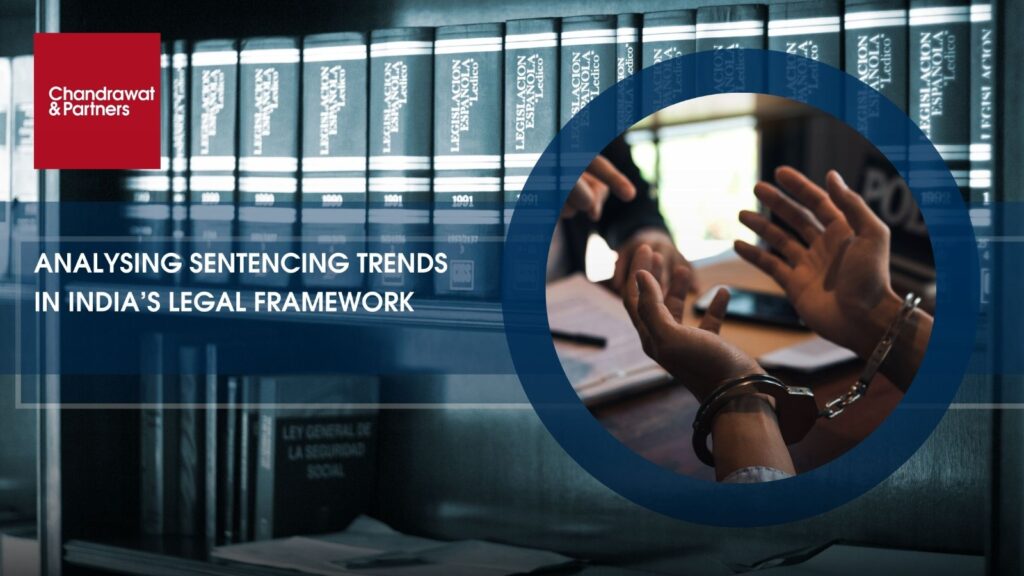
Share :
ANALYZING SENTENCING TRENDS IN INDIA’S LEGAL FRAMEWORK
One of the essential roles of criminal justice administration is to punish offenders and ensure their appropriate treatment. Penal statutes outline the penalties for offenses while granting courts the discretion to determine the severity of the sentence for each offender. In India, the Indian Penal Code, 1860 (“IPC”), previously governed the legal code and the system of sentencing and punishment. However, it was replaced by the Bhartiya Nyaya Sanhita in December 2023.
VARIED JUDICIAL APPROACHES TO SENTENCING IN INDIA
In India, sentencing lacks a uniform policy and is instead influenced by the individual philosophy of judges. Section 53 of the IPC categorizes punishments based on various theories of punishment, allowing courts to impose penalties such as the death penalty, life imprisonment, rigorous or simple imprisonment, forfeiture of property, and fines.
Theories of punishment propose four primary goals: retribution, prevention, reformation, and deterrence. However, each offence under the IPC only specifies maximum and minimum punishments, without defining an appropriate or standard amount of punishment.
RULES AND REGULATIONS APPLIED DURING SENTENCING
- For offenders other than juveniles, a Magistrate, under Section 29 of the Code of Criminal Procedure (“CrPC”), can impose a sentence of imprisonment up to three years, or a fine up to ten thousand rupees, or both.
- When the prescribed punishment for an offence exceeds these limits, the Magistrate cannot impose a sentence beyond these limits but has the option, under Section 325 CrPC, to forward the accused to the Chief Judicial Magistrate.
- Under Section 235 of the CrPC, the Court may hear the accused on the question of sentencing before passing judgment, and Section 235(2) of the CrPC requires the consideration of factors such as the nature of the offence and the character of the offender when determining the sentence.
- Section 361 of the CrPC outline principles to be observed when sentencing juvenile offenders, and the court must record special reasons in its judgment if it deals with an accused under Section 360 of CrPC.
These sections are crucial in guiding the sentencing process to ensure that justice is administered fairly and in accordance with the law. In the case of Gurbachan Singh vs. Satpal Singh, the court emphasized that relying excessively on the benefit of the doubt to acquit suspects does not serve justice for the victim. It is better to let a hundred guilty individuals escape than to punish an innocent one.
INCONSISTENCY IN AWARDING PUNISHMENTS
In the case of Shivaji Chintappa Patil v. State of Maharashtra, the accused was convicted by both the sessions court and the high court under section 302 of the IPC based on a flawed medical examination. Upon review, the Supreme Court of India found that the prosecution had not proven the accused’s guilt beyond a reasonable doubt. The Supreme Court observed that homicidal hangings typically involve more than one person, except in specific situations where the victim is very weak or drugged. Consequently, the Supreme Court overturned the lower courts’ convictions and acquitted the accused of all charges.
In the Kathua rape case, an 8-year-old minor girl was raped in a temple periodically after she was abducted. This heinous crime was comparable to the Nirbhaya rape case. However, while the court awarded the death sentence to the accused in the Nirbhaya case, in the Kathua case, the court imposed only a life sentence.
The Supreme Court acknowledged that the superior courts frequently encounter cases displaying irregularities in sentencing policies. It was noted that ninety percent of trial court judgments are overturned by superior courts due to the lack of a consistent approach to sentencing. The differing outcomes in these cases highlight the ambiguity and uncertainty in India’s sentencing policy.
BALANCING JUSTICE: THE COURTS’ ROLE IN SENTENCING CRIMINALS
Imposing appropriate punishments on criminals is the courts’ method of addressing society’s demand for justice. To serve justice, the court must impose punishment that reflects public abhorrence of the crime. In determining sentences, courts consider various factors, including the rights of the accused, the rights of the victim, and the interests of the public at large. Additionally, undue sympathy toward any party can undermine the criminal justice system. Therefore, it is the court’s duty to impose suitable sentences on the accused, considering the gravity of the offence and other relevant factors that influence the determination of punishment.
HOW WE CAN HELP?
- Our team expertly navigates India’s legal system, formulating effective strategies for every unique circumstance.
- We diligently defend rights, addressing disparities and encouraging fair sentencing outcomes.
- We represent clients in court, ensuring their interests are protected.
- We assist in the preparation and submission of legal documents, ensuring accuracy and compliance with legal standards.
- Our services include mediation and negotiation to resolve disputes efficiently and amicably.
- We provide support for appeals and post-conviction relief, striving for the best possible outcomes for our clients.
- We offer continuous communication and updates, keeping clients informed throughout the process.
For more information or queries, please email us at
enquiries@chandrawatpartners.com


